 How do we walk that last mystery of life with our beloved animal companions? How does the human-animal bond end?
How do we walk that last mystery of life with our beloved animal companions? How does the human-animal bond end?
I write this as our mystery is over: I lost my dying dog, my beloved Murphy, on March 8, 2012. I continue with our diary because her life ran out before our story did, and our story matters. We lived it passionately and clearly: it is helping others deal with their own impending mysteries.
Murphy had splenic cancer: at least we’re pretty sure she did. On Dec. 26, 2011, I took her to the vet for a slight cough: that led to a diagnosis of bronchitis and anemia and infection, and finally to splenic cancer. A radiologist confirmed it on ultrasound, and on January 12, 2012, a surgical specialist in Seattle told me she was pretty certain it was cancer.
Splenic cancer. You don’t beat this cancer. Ever. You can only delay it. The specialist figured it had only been there a month (about the time I noticed a subtle difference in what I thought was progressing arthritis). It is unusual to find it before a crisis develops, but the end result is the same.
If it was cancer, Murphy would live six months with surgery and chemo, three months without.
If it wasn’t cancer (and three vets were now sure it was), it was still growing and would kill her if it wasn’t removed. The surgery itself might kill her.
How do you make these choices?
What in hell do you do?
Get the Facts
Some people say they don’t want to know if their beloved animal is dying.
I say my definition of a multi-species family is you’re lucky if you get to know what you’re dealing with. In Murphy’s case, the vets were pretty sure it was cancer, an aggressive cancer you never beat.
Our best advice here: sit down, write a list of questions, and fill in the blanks. Take it all to a trusted vet and go over it in detail.
I looked at the X-ray, read the report, participated in the actual ultrasound, had Murphy examined by a surgical specialist who had a lot of experience with it.
We looked hard at Murphy: at 13-1/2 she was old and arthritic, although mostly comfortable on Rimadyl. She had bronchitis, heart arrhythmia, and a mild heart murmur.
Surgery was possible but risky. She’d need several days in intensive care and about 10 days recovering before she could walk comfortably. We had stairs to negotiate and I am handicapped: I would simply not be able to provide her the level of care she’d need, so we’d have to hire help.
All possible, but was it necessary? Should we do it? Why or why not?
Murphy and I had a years-old deal: we’d come together in this lifetime, in a safe place, to heal. We’d done that. I’d promised her I wouldn’t ask her to do any more. This seemed like too much: for her and for us. But I’d go with her decision.
It wasn’t that easy, of course, because her decision was this: she believed her body was gradually breaking down, that she was dying anyway, and she believed she’d have more time if we did not operate.
What did the vets think?
Well, that’s part of the blessing, and the curse, isn’t it?
Get the Vet
We parted ways with our long-time vet because she insisted we do things her way.
“You tell the vet you want as much time with her as possible,” she said. Operate and remove it and do chemo.
What I heard: “Torture your dog to keep her with you a few months longer.”
What was really meant: “We force them to stay for our sake, disregarding the quality of their lives, and I the vet am the boss and you do what I say.”
So, bottom line: make sure you and your vet are on the same page. We hadn’t seen the vet we ended up with in years. He was there for us: calm, precise, balanced. He didn’t tell me what to do. He told me what it would look like, and left the decision to us: to me and Murphy. Where it belonged.
What do you do? Make sure you have a vet whose mindset matches yours. Stay informed. Run from anyone who insists that you should do what they want. It’s not their family: it’s yours.
Paternalism should die before we do.
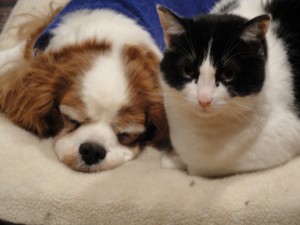
Grace the Cat guards her sister's dreams
Get Support
Tell your friends and family what’s going on. You will end up making new friends and losing old ones. Both are fine. Death is part of living: if anyone in your circle can’t handle it, they can’t handle life. You don’t need them.
Ask for help. I knew there might be problems if Murphy went into crisis in the middle of the night and we needed help to get to the ER. Asking someone to be available to drive you is a big deal: emotionally and physically. Think about who in your circle could possibly help. Ask, but be clear that it’s strictly up to them, and make no judgments on who agrees, who ignores you, and who says no. And why. It’s a growth process all around.
Backup helps. I wouldn’t leave Murphy for more than a few hours those last 2-1/2 months: with a splenic tumor, a crisis could occur in an hour (ultimately, it did). Some people called and wanted to stay with the kids for a few hours, to give me a break. Excellent.
Remember: people are grieving with you, in their own way. Let them help. Let them bow out. Keep the lines open.
I am grateful for everyone who did or did not show up for us. I found a new level of community in the process.
How will you find yours?
Chart Your Course
I knew what we were facing. I focused on comfort and care. We used acupuncture and herbs (thank you, Darla Rewers, DVM, for greeting Murphy so cheerfully, picking up where we’d dropped off a few years before, and helping us with acupuncture, holistic remedies, and loving advice) and the good food and medications we were already using.
I looked at dying naturally and at euthanasia, and what the cancer would actually do to her.
I looked at hospice alternatives for animals and created my own: after all, I was not a stranger to death.
I was grateful that I’d spent so much time over the years learning about veterinary medicine and thinking about creating families with animals: I knew what I wanted my family life to look like, and I knew what my animals wanted it to be like.
I discussed this all with Murphy. And the rest of the family: Alki, my Cavalier boy, and Grace the Cat.
And then we lived our lives together: we walked the mystery, step by step.
We loved.
So here’s what you do: if you’re lucky enough to know the end is coming, find out as much as you can about what it will look like, and figure out how you can live through it so the only regret you have at the end is that you ran out of time. You’re the only one who knows what that will look like to you.
If you don’t know it’s happening, here’s what you do: you stop right now and make sure each day is one you’re grateful for. Live a full life with your animal family. There is no other way.
Hire an Intuitive
I am an intuitive: people pay me and my crystal partner, Fallon, to talk to things with them.
I was smart enough to hire someone else to talk with us.
That means I had someone talk with Murphy and with me regularly throughout the process. I could sit back and be the client: I could hear what Murphy thought and felt, and she could hear me, and a compassionate, objective, loving intuitive could be the bridge between us.
That intuitive is Debrae FireHawk. In the process she relived the loss of her own dog, which helped her as well.
With that support Murphy and I said goodbye to each other. We grieved losing each other. We cried. We accepted. At some point, she became excited about the new life she was moving towards, a bittersweet moment for me.
And then she died.
© 2012 Robyn M Fritz
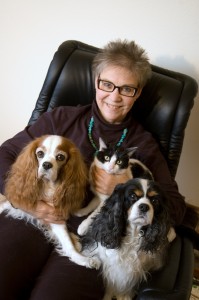 I first published this article on January 17, 2011. On March 8, 2012, the story changed: that was the day I lost my beloved Cavalier, Murphy. In the coming days and weeks I will have much to say about grief, dying, death, and loss, but for now, perhaps this says it best. Twice a day I miss Murphy the most: the times when it’s achingly clear that our daily family ritual is over, because Murphy is gone. The bed is now bigger, my heart is emptier, Alki is a depressed single dog and Grace the Cat prowls restlessly. Several weeks later we are still feeling our way through new rituals: Alki is beginning to like getting his ears rubbed, but he doesn’t snuggle as long or deeply as Murphy did; when he’s ready to get up he’s ready, although he’ll wait patiently for me to move. Grace the Cat comes up several times, early in the morning, both seeking and giving comfort, always in search of a gentle pet and a warm snuggle.
I first published this article on January 17, 2011. On March 8, 2012, the story changed: that was the day I lost my beloved Cavalier, Murphy. In the coming days and weeks I will have much to say about grief, dying, death, and loss, but for now, perhaps this says it best. Twice a day I miss Murphy the most: the times when it’s achingly clear that our daily family ritual is over, because Murphy is gone. The bed is now bigger, my heart is emptier, Alki is a depressed single dog and Grace the Cat prowls restlessly. Several weeks later we are still feeling our way through new rituals: Alki is beginning to like getting his ears rubbed, but he doesn’t snuggle as long or deeply as Murphy did; when he’s ready to get up he’s ready, although he’ll wait patiently for me to move. Grace the Cat comes up several times, early in the morning, both seeking and giving comfort, always in search of a gentle pet and a warm snuggle. 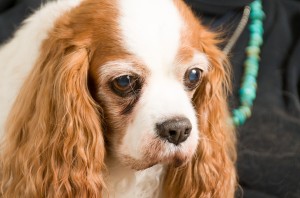
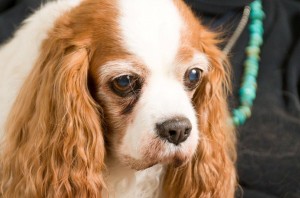 Murphy Brown Fritz
July 16, 1998 – March 8, 2012
Beloved companion
Devoted sister
Terror of squeaky toys
Friend to the universe
Murphy Brown Fritz
July 16, 1998 – March 8, 2012
Beloved companion
Devoted sister
Terror of squeaky toys
Friend to the universe
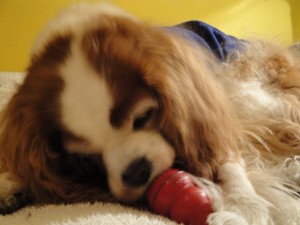 Most of the time, Dr. Weh explained, the tumors abruptly bleed and the animals go into crisis, when they had appeared perfectly healthy the day before. It happens, but it isn’t as common to find it early like we did, before there were obvious signs of a problem, like a bleeding episode or swollen belly.
Most of the time, Dr. Weh explained, the tumors abruptly bleed and the animals go into crisis, when they had appeared perfectly healthy the day before. It happens, but it isn’t as common to find it early like we did, before there were obvious signs of a problem, like a bleeding episode or swollen belly.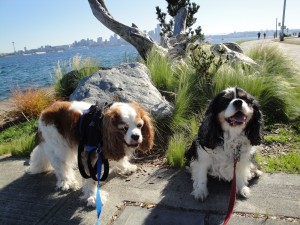 And what about cost? The initial surgery and stay alone would be about $3000, barring complications. Frankly, I couldn’t afford it, I just couldn’t. But I’d find a way if I could help her, because that’s just what you did. Everything we’ve faced together as a family had been to beat something that we could beat, to give Murphy a healthy, happy life, to give her the chance to make her contribution to the family and to the world. To do the right thing.
And what about cost? The initial surgery and stay alone would be about $3000, barring complications. Frankly, I couldn’t afford it, I just couldn’t. But I’d find a way if I could help her, because that’s just what you did. Everything we’ve faced together as a family had been to beat something that we could beat, to give Murphy a healthy, happy life, to give her the chance to make her contribution to the family and to the world. To do the right thing.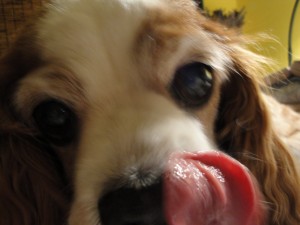 And, as this second photo will prove: satisfied.
And, as this second photo will prove: satisfied.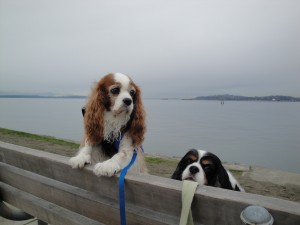 It passes, and we wonder, where did it go? As we sat on the deck together in the cooling afternoon sun, I thought of all the things I could be doing: writing another article, cleaning house, updating my website, the things we do to live.
It passes, and we wonder, where did it go? As we sat on the deck together in the cooling afternoon sun, I thought of all the things I could be doing: writing another article, cleaning house, updating my website, the things we do to live.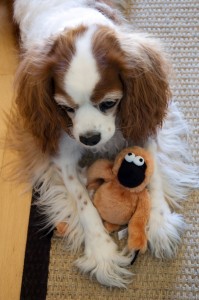 Two days later Murphy was still occasionally coughing, and I wasn’t convinced we were on the right track. But I had work to do. My partner, Fallon, is a Citrine Lemurian Quartz—yes, he’s a crystal ball. We do intuitive consultations privately and at
Two days later Murphy was still occasionally coughing, and I wasn’t convinced we were on the right track. But I had work to do. My partner, Fallon, is a Citrine Lemurian Quartz—yes, he’s a crystal ball. We do intuitive consultations privately and at 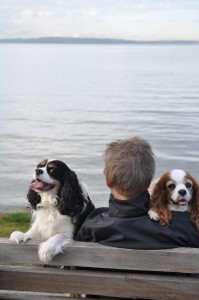 Interesting.
Interesting. Do Alki and Grace the Cat care? Does anybody care?
Do Alki and Grace the Cat care? Does anybody care?





















